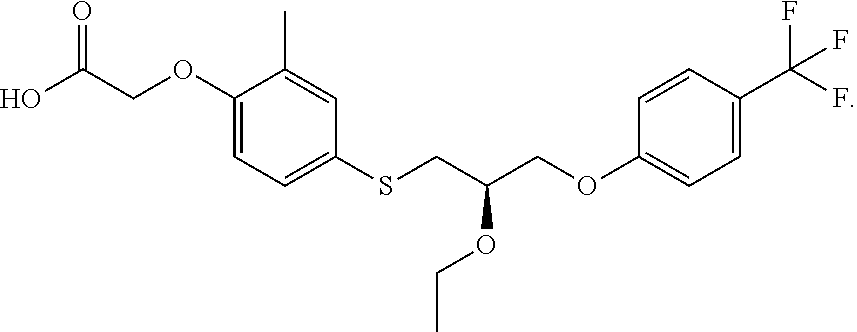Treatment of intrahepatic cholestatic diseases
a cholestatic disease and intrahepatic technology, applied in the direction of drug compositions, organic active ingredients, pharmaceutical delivery mechanisms, etc., can solve the problems of scarring, fibrosis and cirrhosis, liver disease worsening, etc., to reduce cholestasis, effective treatment, and alkaline phosphatase.
- Summary
- Abstract
- Description
- Claims
- Application Information
AI Technical Summary
Benefits of technology
Problems solved by technology
Method used
Image
Examples
example
[0037]Adult subjects with an intrahepatic cholestatic disease such as PBC are treated with doses of 50, 100, 150, or 200 mg / day of MBX-8025. Subjects are permitted their usual other medications, including UDCA. The subjects are assessed before the study, and at intervals during the study, such as every 4 weeks during the study and 4 weeks after the last dose of the MBX-8025 therapy, for safety and pharmacodynamic evaluations. At each visit, after a 12-hour fast, blood is drawn and urine collected; and a standard metabolic panel, complete blood count, and standard urinalysis are performed. Blood is analyzed for TC, HDL-C, TG, VLDL-C, LDL-C, and apolipoprotein B, for liver function markers such as total and bone-specific alkaline phosphatases, for γ-glutamyl transpeptidase, and also for total and conjugated bilirubin. The subjects also maintain health diaries, which are reviewed at each visit. The subjects show a dose-related improvement in their disease, as manifested by, for example...
PUM
 Login to View More
Login to View More Abstract
Description
Claims
Application Information
 Login to View More
Login to View More - R&D
- Intellectual Property
- Life Sciences
- Materials
- Tech Scout
- Unparalleled Data Quality
- Higher Quality Content
- 60% Fewer Hallucinations
Browse by: Latest US Patents, China's latest patents, Technical Efficacy Thesaurus, Application Domain, Technology Topic, Popular Technical Reports.
© 2025 PatSnap. All rights reserved.Legal|Privacy policy|Modern Slavery Act Transparency Statement|Sitemap|About US| Contact US: help@patsnap.com

